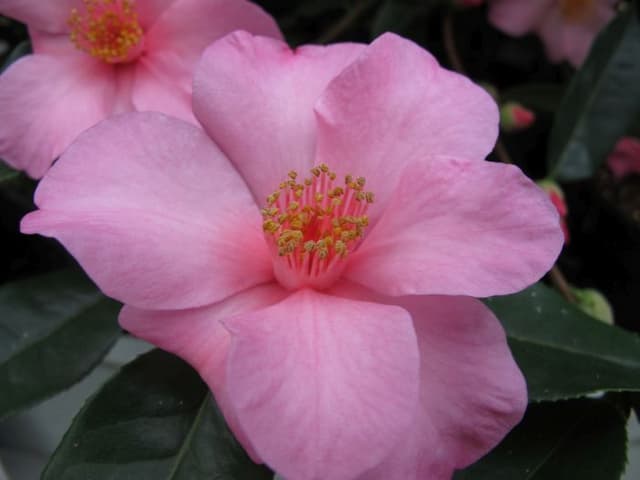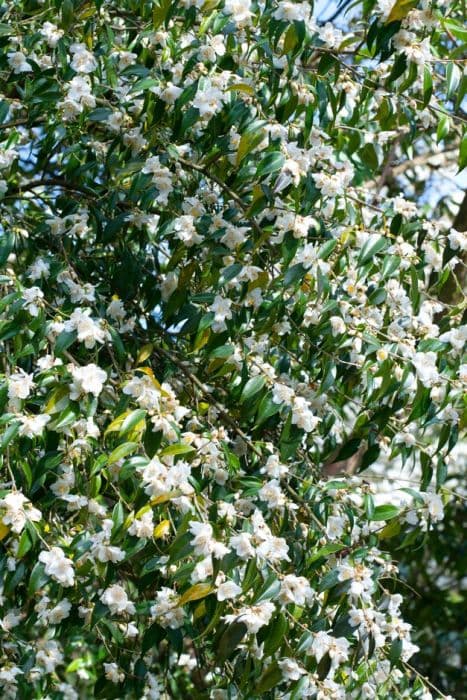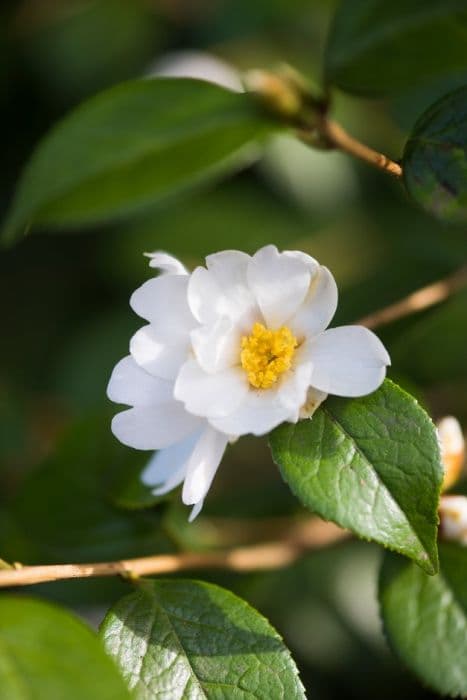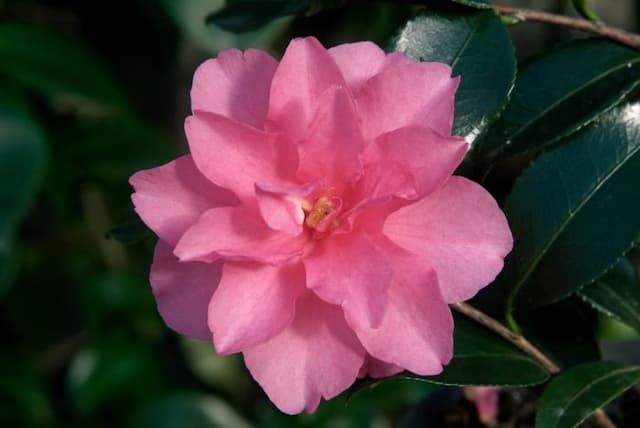Williamsii Camellia Camellia × williamsii 'Golden Spangles' (v)

ABOUT
Camellia 'Golden Spangles' is a visually striking plant known for its unique and ornamental foliage, which sets it apart from other varieties. The leaves are variegated, exhibiting splashes of yellow and golden hues that intermingle with a deep green background, creating a dazzling display. This variegation leads to a mesmerizing pattern on each leaf, reminiscent of sunlight dancing across the surface of a forest floor. The flowers of the Camellia 'Golden Spangles' contribute to its beauty, typically blooming in the cooler weather of fall into the early spring months. These flowers boast a classic camellia form, which may be single, semi-double, or fully double in shape, adding a further layer of texture and visual interest to the plant. The blossoms come in various shades, often in tones of pink or red and sometimes exhibiting white streaks or edges, providing a lovely contrast against the ornate foliage beneath. This variety maintains the characteristic glossy look of camellia leaves, which adds a luxurious touch to the plant's overall appearance. Despite the exclusion of exact dimensions, it is worth noting that the plant's growth habit tends to be dense and bushy, providing a substantial visual impact in a garden setting. Overall, the Camellia 'Golden Spangles' displays a combination of elegant blooms and strikingly patterned foliage, making it a distinctive and attractive choice for gardeners looking to enhance their landscape with a splash of color and a touch of the exotic.
About this plant
 Names
NamesSynonyms
Golden Spangles Camellia, Variegated Williamsii Camellia.
Common names
Camellia × williamsii 'Golden Spangles' (v)
 Toxicity
ToxicityTo humans
Williamsii Camellias, including 'Golden Spangles', are generally not considered toxic to humans. They do not typically cause poisoning if ingested, and no significant symptoms are expected to occur. Therefore, accidental ingestion of parts of this plant should not result in any serious consequences. However, despite its low toxicity, it's always prudent to avoid eating ornamental plants due to potential individual allergic reactions or irritation.
To pets
Williamsii Camellias, like 'Golden Spangles', are also generally considered non-toxic to pets. Ingesting parts of these plants is not expected to cause poisoning in pets such as cats and dogs. There should not be any severe symptoms from ingestion, and it is considered to be of low concern in regards to pet health. As with humans, although the plant is not toxic, it is best to prevent pets from consuming plant material to avoid any potential gastrointestinal upset or individual allergic reactions.
 Characteristics
CharacteristicsLife cycle
Perennials
Foliage type
Evergreen
Color of leaves
Variegated
Flower color
Pink
Height
6-8 feet (1.8-2.4 meters)
Spread
4-6 feet (1.2-1.8 meters)
Plant type
Shrub
Hardiness zones
7
Native area
East Asia
Benefits
 General Benefits
General Benefits- Aesthetic Appeal: Camellia 'Golden Spangles' offers a visually stunning display with its variegated foliage and vibrant flowers, enhancing the beauty of gardens and landscapes.
- Year-Round Interest: This plant provides year-round interest with its evergreen leaves and seasonal blooms, offering a focal point in garden designs throughout the year.
- Wildlife Attraction: The flowers attract pollinators such as bees, providing a valuable food source for these insects and encouraging biodiversity within the garden ecosystem.
- Privacy Screen: Due to its dense growth habit, Camellia 'Golden Spangles' can be used to create a natural privacy screen or hedge, offering seclusion and reducing noise pollution.
- Limited Maintenance: Once established, Camellia 'Golden Spangles' is relatively low-maintenance, requiring minimal care beyond occasional pruning and watering during dry spells.
- Shade Tolerance: This plant is tolerant of partial shade, making it a versatile choice for gardeners with shaded areas where other plants may not thrive.
- Versatility in Landscaping: Suitable for a range of landscaping uses, including borders, specimen planting, and container growing, allowing for flexibility in garden design.
- Soil Adaptability: While preferring acidic and well-draining soil, Camellia 'Golden Spangles' can adapt to a range of soil types with the proper care and attention.
 Medical Properties
Medical PropertiesThis plant is not used for medical purposes.
 Air-purifying Qualities
Air-purifying QualitiesThis plant is not specifically known for air purifying qualities.
 Other Uses
Other Uses- Photography subjects: Camellia 'Golden Spangles' blooms can serve as striking subjects for macro photography, showcasing their unique variegated foliage and flowers.
- Educational resources: These plants can be used in botany classes to demonstrate hybridization and genetic variations in plants.
- Artistic inspiration: Artists may use Camellia 'Golden Spangles' as models for paintings, drawings, and other forms of botanical art.
- Fashion design: The distinctive pattern of the leaves and flowers can inspire textile patterns and color schemes in fashion design.
- Seasonal decorations: The blooms and foliage can be included in floral arrangements or wreaths for decorative purposes during their blooming season.
- Culinary presentation: Although not edible, the flowers may be used as temporary, non-toxic garnishes for plating high-end dishes.
- Workshops and demonstrations: The plant can be a feature in gardening workshops focused on care for variegated plants or winter gardening.
- Cultural events: Camellia 'Golden Spangles' can be the centerpiece in flower shows or horticultural competitions that focus on camellias.
- Relaxation spaces: The plant's aesthetically pleasing appearance can contribute to the ambiance and aesthetic of spas or relaxation areas.
- Theme gardens: The Camellia 'Golden Spangles' can be incorporated into theme gardens based on color patterns or variegated foliage.
Interesting Facts
 Feng Shui
Feng ShuiThe Camellia is not used in Feng Shui practice.
 Zodiac Sign Compitability
Zodiac Sign CompitabilityThe Camellia is not used in astrology practice.
 Plant Symbolism
Plant Symbolism- Admiration - The camellia typically symbolizes admiration, and the 'Golden Spangles' variety, with its striking variegated leaves and flowers, enhances this sentiment with its unique beauty, drawing even more attention and evoking deeper admiration.
- Perfection - Camellias are often associated with perfection due to their flawless, symmetrical blooms. The 'Golden Spangles' variety continues this tradition with its ornamental appeal.
- Longevity and Gratitude - In some cultures, camellias represent the longevity of life, gratitude, and the spirit of endurance. The robust nature of Camellia × williamsii 'Golden Spangles' reflects this symbolism well.
- Love and Affection - Like many camellias, 'Golden Spangles' could also represent love, affection, and deep romantic desire owing to its lush, colorful petals, making it a perfect gift for a loved one.
 Water
WaterGolden Spangles camellias require consistent moisture but do not like to be waterlogged. They should be watered thoroughly whenever the top inch of soil feels dry to the touch. During the growing season, this may mean watering every week, but in cooler months, water less frequently. Be sure to provide water slowly and deeply, allowing it to reach the roots rather than just wetting the surface. A mature plant will generally require about 1-1.5 gallons per week, depending on climate and soil conditions.
 Light
LightGolden Spangles camellia thrives in partial shade, as direct sunlight can scorch the leaves while too much shade can reduce flowering. The best spot for this plant would be one where it can receive filtered sunlight or morning sun with afternoon shade. Protect the plant from the hot midday sun to preserve the vibrant colors of its foliage and flowers.
 Temperature
TemperatureGolden Spangles camellias prefer moderate temperatures and are hardy in USDA zones 7-9. They can tolerate minimum temperatures down to about 0 degrees Fahrenheit but prefer a range between 40 to 70 degrees for optimal growth. Avoid placing them in locations where temperature fluctuations are extreme.
 Pruning
PruningPruning Golden Spangles camellia is best done after flowering has ceased, typically in late winter or early spring. Prune to maintain shape, remove dead or weak wood, and promote airflow. Pruning every two to three years is often sufficient, but annual removal of interior deadwood can be beneficial. The best time for pruning is when the plant is dormant and before new growth begins.
 Cleaning
CleaningAs needed
 Soil
SoilThe best soil mix for Camellia × williamsii 'Golden Spangles', commonly known as Golden Spangles Camellia, should be well-draining and acidic with a pH between 5.5 and 6.5. An ideal mix can be made of equal parts of peat moss, pine bark, and perlite or coarse sand to ensure good aeration and moisture retention.
 Repotting
RepottingGolden Spangles Camellia typically needs repotting every 2 to 3 years to prevent becoming root-bound and to replenish its soil. It’s best to repot in late winter or early spring before the growing season starts.
 Humidity & Misting
Humidity & MistingGolden Spangles Camellia prefers high humidity levels, around 50-80%. They thrive in moist, but not wet, air environments, avoiding excessively dry conditions which can cause bud drop and leaf desiccation.
 Suitable locations
Suitable locationsIndoor
Ensure bright, indirect light and high humidity.
Outdoor
Protect from direct sun; shelter from cold, drying winds.
Hardiness zone
7-9 USDA
 Life cycle
Life cycleCamellia × williamsii 'Golden Spangles', commonly known as Variegated Williamsii Camellia, begins its life cycle with seed germination, though cultivated plants are often propagated via cuttings to maintain variegation. After rooting, the plant enters a juvenile growth stage where it establishes a strong root system and begins to develop its distinctive glossy, variegated leaves. The vegetative stage follows, characterized by periods of active growth where the plant increases in size and produces more foliage. The plant then reaches maturity and starts the reproductive phase, characterized by the production of its notable flowers, typically blooming in late winter to early spring. After pollination, the flowers can give way to seed capsules if conditions are favorable, though breeding in variegated cultivars is often achieved through cuttings rather than seeds. As a perennial, the Variegated Williamsii Camellia will go through repeated cycles of growth and reproduction, with proper care ensuring a lifespan of many years.
 Propogation
PropogationPropogation time
Spring-early summer
Propogation: The most popular method for propagating Camellia × williamsii 'Golden Spangles', commonly referred to as Williams' Camellia, is through semi-hardwood cuttings. This process typically occurs during the late summer months. To propagate by cuttings, select healthy, semi-hardwood stems that have matured after the spring growth. The cuttings should be about 4 to 6 inches (about 10 to 15 centimeters) long and include several leaf nodes. The lower leaves are removed, and the base of the cutting is dipped into a rooting hormone to encourage root development. The treated cuttings are then inserted into a potting mix with good drainage and kept under high humidity and indirect light until roots have formed, which can take several weeks to a few months. Regular misting and a consistent temperature are crucial during this time to ensure successful rooting.









